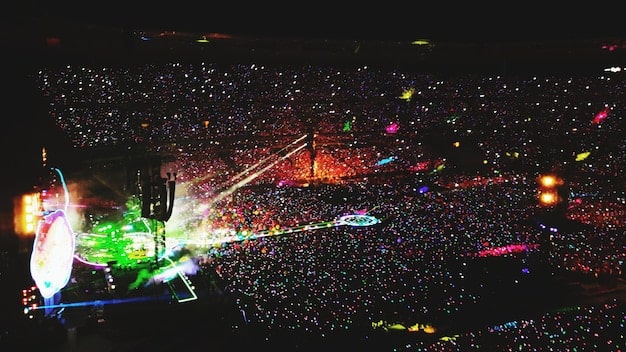J-Pop’s US Takeover: Exploring the Fanbase Surge & Cultural Influence

The Rise of J-Pop in the US: A Look at the Growing Fanbase and Cultural Impact explores the increasing presence and influence of Japanese pop music within the United States, examining its dedicated fanbase and its profound effects on American culture.
The infectious beats, vibrant visuals, and captivating performances of Japanese pop music, or The Rise of J-Pop in the US: A Look at the Growing Fanbase and Cultural Impact, have been steadily gaining traction in the American music scene. What started as a niche interest has blossomed into a full-blown cultural phenomenon, transforming how many Americans perceive and interact with international music.
Understanding the J-Pop Phenomenon
J-Pop, short for Japanese pop music, is a genre encompassing a wide array of styles and subgenres. Its unique production, emphasis on visual aesthetics, and dedicated idol culture set it apart from typical Western pop music. Understanding the elements is key to appreciating its increasing popularity in the US.
What Defines J-Pop?
J-Pop’s distinct sound and cultural context are significant factors in its appeal. From bubblegum pop tunes to complex instrumental arrangements, J-Pop offers an immersive experience that goes beyond just the music.
Key Characteristics of J-Pop
Several characteristics define J-Pop and distinguish it from other genres of pop music. These distinct elements contribute to its widespread appeal and growing fanbase in the US. These range from a focus on high-energy performances to elaborate visual aesthetics and a strong emphasis on fan interaction.
- Catchy Melodies: J-Pop songs are known for their infectious and memorable melodies that resonate with a wide audience.
- Diverse Sounds: The genre includes various musical styles, blending traditional Japanese sounds with modern pop, rock, and electronic elements.
- Visual Appeal: Music videos and live performances often feature vibrant colors, elaborate costumes, and synchronized dance routines.
J-Pop’s multifaceted appeal lies in its ability to deliver a complete sensory experience. By combining catchy and diverse music with engaging visuals, J-Pop has carved out a significant niche in the global music scene.

The History of J-Pop’s Expansion into the US
The journey of J-Pop’s infiltration into the US has been a gradual yet transformative process, shaped by fandoms, technological advancements, and strategic marketing initiatives. From its humble beginnings in niche anime conventions to its current status on mainstream platforms, J-Pop’s rise is a testament to its universal appeal and the power of cultural exchange.
Early Days: Anime and Conventions
Anime and Japanese culture conventions were among the first venues where J-Pop gained visibility in the US. These events provided spaces for fans to gather, share their enthusiasm, and discover new artists. It became a place of cultural exchange and a breeding ground for J-Pop fandom.
The Role of the Internet and Social Media
The internet has played a pivotal role in the proliferation of J-Pop fandom. The rise of platforms like YouTube, Spotify, and social media networks has allowed artists to reach global audiences directly, bypassing geographical barriers. It has also allowed for closer connections between artists and fans.
- YouTube: A critical platform for J-Pop groups to release music videos and promotional content, allowing fans worldwide to discover new music
- Social Media: Platforms like Twitter, Instagram, and TikTok for direct interactions between artists and fans
- Streaming Services: Spotify, Apple Music, and other services providing easy access to vast libraries of J-Pop music, expanding listeners
Online platforms have been essential in J-Pop’s conquest of the American market. They have democratized access to music, fostered stronger fan communities, and facilitated real-time interaction between fans and artists, leveling the playing field for J-Pop artists wishing to gain fans.
Factors Contributing to the Growing Fanbase
Several intertwined factors explain the rapid increase in J-Pop’s fanbase in the US. From the genre’s unique aesthetic appeal to the increasing acceptance of global music, multiple elements have converged to create the perfect conditions for J-Pop’s explosion in popularity. Authenticity, innovation, and community have also contributed to this growth.
Unique Musical and Visual Aesthetic
J-Pop distinguishes itself through its captivating melodies, vibrant visuals, and highly choreographed performances. The genre’s commitment to these elements resonates with fans seeking a holistic entertainment experience.
The Rise of Global Music Consumption
The increasing globalization of music consumption has played a huge role in J-Pop’s spread. As streaming services gain popularity, people are finding it easier than ever to access music from around the world, regardless of language barriers.
- Cultural Exchange: Encouraging cross-cultural understanding and appreciation through music.
- Diverse Representation: The diverse origins and backgrounds attract listeners from various cultural backgrounds.
- Breaking Barriers: Global music consumption is slowly eroding the dominance that Western artists have had on the popular music landscape.
Global music consumption has allowed for the exploration of genres previously unknown, fostering cross-cultural connections and diversification of mainstream music.

The Cultural Impact of J-Pop in the US
J-Pop’s influence extends beyond the music charts, leaving an impact on American fashion, dance, and artistic expression. The spread of J-Pop in the US has spurred a cultural exchange, influencing everything from fashion trends to dance movements.
Influence on Fashion and Style
The vibrant and often avant-garde fashion of J-Pop artists has inspired new trends in American youth culture. From street style to high fashion, J-Pop’s influence is discernable in many contemporary looks.
J-Pop Inspired Dance Trends
The complex choreography and synchronized dance moves associated with J-Pop have led to the emergence of dedicated dance communities in the US. These groups often perform covers of J-Pop dances and organize workshops.
Dance and fashion have merged.
Challenges and Criticisms
Despite its growing popularity, J-Pop also faces its share of challenges and criticisms in the US market. Stereotypes, cultural appropriation, and industry practices are prominent among these concerns. Addressing these issues is crucial for the continued growth and acceptance of J-Pop in the US.
Addressing Stereotypes
The perception of J-Pop is sometimes tainted by stereotypes portraying it as overly manufactured or inauthentic. Overcoming these stereotypes requires showcasing the genre’s artistic merit and cultural depth.
Cultural Appropriation vs. Appreciation
The fine line between cultural appreciation and appropriation is a recurring topic in the context of J-Pop’s global expansion. It is important for fans and artists to approach J-Pop culture with respect and authenticity.
It requires cultural sensitivity.
The Future of J-Pop in the US
Looking ahead, the future of J-Pop in the US appears bright, albeit with the need for continual adjustment and innovation. The increasing integration of global music in everyday life, coupled with J-Pop’s flexibility to adapt to changing consumer preferences, indicates sustained growth. Navigating challenges, embracing diversity. and leveraging technology will be essential for J-Pop’s continued growth in the US.
Embracing Diversity and Inclusion
Embracing diversity and inclusion is a step to ensuring relevance and appeal to the diverse American audience. Showcasing artists and themes that reflect a wide array of experiences is vital as the mainstream acceptance grows.
Leveraging Technology and Innovation
Adopting new technologies and platforms is crucial for broadening J-Pop’s reach in the US. From interactive streaming events to VR concerts, incorporating these innovations will keep J-Pop at the forefront of music consumption.
| Key Point | Brief Description |
|---|---|
| 🎶 Musical Diversity | J-Pop blends traditional Japanese sounds with global pop, rock, and electronic elements. |
| 💻 Internet Boost | Platforms like YouTube and Spotify drive J-Pop’s global reach. |
| 💃 Dance & Fashion | J-Pop influences American fashion trends and inspires vibrant dance communities. |
| 🤝 Cultural Exchange | J-Pop fosters cross-cultural understanding and appreciation through music. |
Frequently Asked Questions
▼
J-Pop, short for Japanese pop, includes various music styles from bubblegum pop to rock, always focusing on vibrant melodies and appealing visuals. It stands out with unique production styles and strong idol focus.
▼
J-Pop first gained popularity in the US through anime conventions and the internet. Online platforms like YouTube and social media helped propel J-Pop to a global audience, fostering a very dedicated fan base.
▼
J-Pop often revolves around themes of love, friendship, and everyday life, but also includes fantasy and futuristic elements. What sets it apart is the positive and uplifting tone, which resonates with many fans.
▼
J-Pop has a visible impact on American fashion, dance, and visual arts. J-Pop trends can be seen in streetwear and pop culture art, demonstrating its increasing integration into the U.S. cultural landscape.
▼
J-Pop faces challenges such as cultural stereotypes and possible appropriation. Maintaining respect for Japanese culture while broadening appeal is crucial for the future growth and acceptance of the genre.
Conclusion
The ascent of J-Pop in the United States has been remarkable, fueled by catchy melodies, visual appeal, and the power of online communities. Despite challenges, the genre’s future in the US looks very promising, poised for ongoing evolution and integration into the mainstream.





